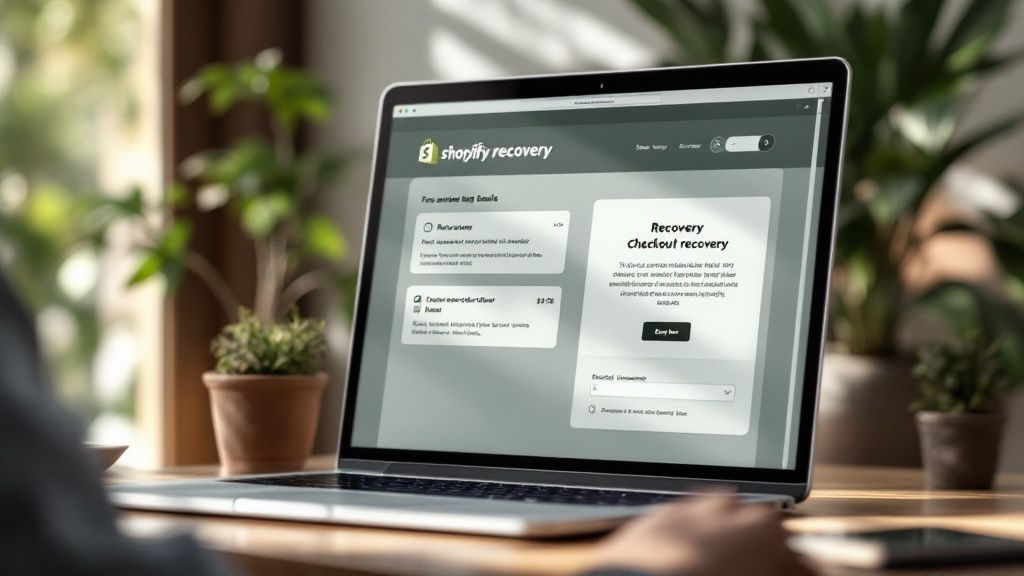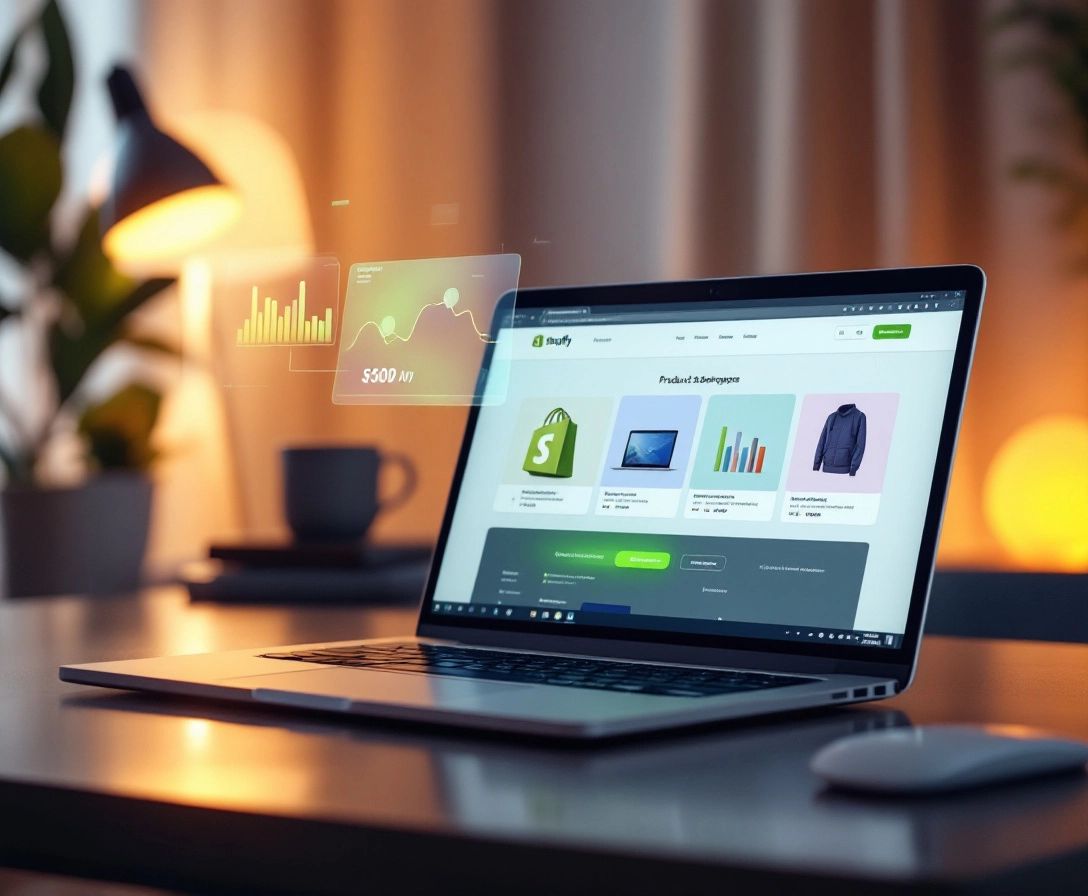Mastering Shopify Abandoned Checkout: Transform Failed Sales Into Revenue
February 4, 2025

Understanding the Real Impact of Abandoned Checkouts

When customers abandon their Shopify carts without completing a purchase, it affects more than just your bottom line. These abandoned checkouts create a ripple effect that impacts everything from marketing costs to customer insights. To build an effective solution, we first need to understand exactly what's at stake.
Quantifying the Lost Revenue
The numbers tell a compelling story about the scale of abandoned checkouts. According to the Baymard Institute, the global cart abandonment rate has reached 70.19% in 2023, up from 68.07% in 2014. This means that 7 out of 10 potential sales are lost when customers leave items in their cart.
To put this in perspective: if your Shopify store makes $100,000 in monthly sales, you could be losing $70,000 in potential revenue each month due to abandoned carts. That's money that could fund marketing campaigns, store improvements, or other growth initiatives. For more context on these rates, check out detailed abandoned checkout statistics.
Beyond the Immediate Loss: The Hidden Costs
The true cost of abandoned checkouts goes deeper than lost sales. Every customer who abandons their cart represents wasted marketing spend – the money you invested to bring them to your store in the first place. For instance, if you're running paid ads, each abandoned checkout means you paid for a click that didn't convert into a sale.
These abandonments also muddy your customer data. When shoppers abandon carts frequently, it becomes harder to understand genuine purchase patterns and create targeted marketing campaigns. This makes it essential to dig into why customers are leaving without buying.
Identifying the Critical Dropout Points
Success in reducing abandoned checkouts starts with pinpointing exactly where customers give up on their purchase. Common friction points include unexpected shipping costs, a complicated checkout process, or limited payment options. By tracking user behavior at each step, you can spot patterns in where most people drop off.
Armed with this knowledge, you can make focused improvements to smooth out the buying process and keep more customers moving toward a completed purchase. The key is to remove obstacles while maintaining the security and functionality your customers expect.
Building a High-Converting Checkout Experience
The checkout process directly impacts your store's bottom line – it's where interested shoppers either complete their purchase or abandon their cart. Even small points of friction during checkout can lead to lost sales and revenue. That's why optimizing this crucial stage is a key priority for successful Shopify stores.
Creating a Simple Checkout Flow
The most effective way to reduce abandoned carts is to minimize the steps between "Add to Cart" and "Order Complete." Just like a smooth assembly line, fewer steps mean fewer opportunities for customers to drop off. Guest checkout options are especially helpful since they remove the friction of account creation for first-time buyers.
Research shows that a complicated checkout process causes 17% of shoppers to abandon their carts (source). To prevent this, focus on:
- Removing unnecessary form fields
- Simplifying the layout and design
- Optimizing page load speed
- Eliminating any confusing or redundant steps
Making the Experience User-Friendly
Beyond reducing friction, the checkout needs to actively guide customers to completion. Clear messaging shows shoppers exactly where they are in the process. Progress indicators and prominent call-to-action buttons help build momentum and confidence. These visual cues reduce anxiety by making each step feel manageable.
Payment options are another key factor. Offering multiple trusted payment methods like PayPal, Apple Pay, Google Pay, and credit cards lets customers pay however they prefer. When shoppers can use their preferred payment method, they're more likely to complete their purchase.
Establishing Trust and Transparency
Security concerns often cause hesitation during checkout, especially for first-time customers. Displaying trusted security badges and using reputable payment gateways helps reassure shoppers that their sensitive information is protected.
Being upfront about shipping costs, delivery times, and return policies also builds confidence. Hidden fees or unclear policies are major reasons for cart abandonment. For more tips on reducing abandoned checkouts, check out this guide on How to master abandoned checkout strategies. Clear communication throughout checkout helps create the trust needed to complete the sale.
Mastering Mobile-First Checkout Success

As shopping on mobile devices becomes the norm, having a smooth mobile checkout process is essential for any Shopify store. Over 70% of ecommerce traffic now comes from mobile devices, making it critical to optimize the checkout experience for smartphone users. Let's explore how to create a mobile checkout that converts.
Designing for Touch and Thumbs
Mobile users interact differently with their devices compared to desktop users. The key is creating a touch-friendly interface that works well with thumb navigation. Make buttons and form fields large enough for easy tapping, and space interactive elements far enough apart to prevent mis-taps. Simple changes like increasing tap target sizes and optimizing spacing can significantly reduce user frustration during checkout.
Optimizing Mobile Load Times
Speed matters tremendously on mobile. Each second of load time reduces conversion rates by 7%. Focus on optimizing images, minimizing code, and using browser caching to ensure your checkout loads quickly on mobile networks. When pages load fast, customers are much more likely to complete their purchase rather than abandoning out of frustration.
Building Mobile Confidence
Security concerns often make mobile users hesitant to complete purchases. Address this by prominently displaying security badges and offering familiar payment options like Apple Pay or Google Pay. Clear messaging about security measures helps build trust. According to recent data, mobile checkout abandonment rates are significantly higher than desktop, making it essential to create a trustworthy experience.
Streamlining the Mobile Checkout Flow
Keep the checkout process simple and focused on mobile. Implement a one-page checkout or express options like Shop Pay to minimize required steps. Remove unnecessary form fields and streamline navigation. The easier you make it for customers to complete their purchase, the higher your conversion rates will be. Remember that every extra tap increases the risk of abandonment.
These mobile-first strategies help create a checkout experience that mobile shoppers expect. When implemented properly, they can dramatically reduce abandoned carts while increasing completed orders and revenue.
Implementing Strategic Recovery Campaigns
Every successful Shopify store needs a solid plan for recovering abandoned checkouts. Basic reminder emails aren't enough – you need carefully designed campaigns that connect with customers at the right time with the right message. Let's look at proven techniques that can help win back those almost-completed sales.
Timing is Everything: The Golden Hour
Quick action is critical when recovering abandoned checkouts. Research shows that sending recovery emails in the first hour leads to the highest success rates, with around 16% of customers completing their purchase. This early window works because the shopping intent is still fresh in their mind.
A single email rarely does the job though. The most effective approach includes a second email 24 hours later and a third after 72 hours. This keeps your products on their radar without becoming annoying. Each message should build on the last while maintaining a friendly, helpful tone.
Crafting Compelling Messaging: Beyond the Generic Reminder
Your message content matters just as much as timing. Don't just remind them what's in their cart – address common reasons why people abandon purchases. You might highlight your free shipping offer, share glowing customer reviews, or provide a special discount code to overcome hesitation.
Make each email personal by using their name and showing images of their specific cart items. Different customer segments may need different approaches based on their shopping history and behavior. Testing various message styles helps you find what works best for your audience.
Incentive Structures That Drive Conversions
Smart incentives can give hesitant shoppers the final push they need to buy. The key is choosing offers that make sense for your business model and brand image. Common options include free shipping, percentage discounts, and fixed amount coupons.
If shipping costs often cause cart abandonment, offering free shipping above a certain order value can be very effective. Time-limited discounts create urgency that motivates quick action. Keep testing different incentive types to see what gets the best response from your customers. Find more tips in our guide on How to master abandoned checkout recovery with expert strategies.
Multi-Channel Recovery: Expanding Your Reach
While email remains the main recovery tool, adding SMS and push notifications can boost your success rate. These additional channels let you reach customers more quickly and work especially well for limited-time offers.
For example, sending a brief SMS soon after cart abandonment with a small incentive can effectively bring customers back to complete their purchase. Using multiple channels thoughtfully – without overwhelming customers – helps maximize your recovery efforts and increase sales.
Using Data to Improve Your Checkout Process

Simply tracking your Shopify abandoned checkout rate isn't enough. Reducing lost revenue requires understanding why customers leave their carts behind and using actual data to make your checkout better. Let's explore how to move beyond basic metrics into data-driven improvements.
Finding Key Metrics and Understanding User Behavior
While the overall abandoned checkout rate gives you a general picture, specific metrics reveal much more. Key metrics to track include:
- Cart abandonment by device (mobile vs desktop)
- Dropout rates at each checkout step
- Abandonment patterns by product type
For example, if mobile users abandon carts much more often than desktop users, this clearly points to mobile experience issues that need fixing.
Using analytics tools shows exactly where customers get stuck. By looking at time spent per page, form field completion rates, and exit points, you can spot friction areas like confusing forms or unclear shipping policies that cause people to leave.
Detailed Tracking to Find Pain Points
Event tracking and funnel analysis give you an up-close view of customer actions during checkout. Event tracking monitors specific interactions like button clicks, while funnel analysis maps the full customer journey through your checkout steps. This precision helps identify exactly where and why customers drop off.
Heatmaps and session recordings provide visual insights into customer behavior. Heatmaps highlight where users click and scroll most, showing points of interest or confusion. Session recordings let you watch actual customer interactions, making it clear when they run into trouble. These visual clues are essential for spotting usability problems.
Making Data-Driven Improvements
Regular testing is key to optimization. A/B testing different versions of your checkout – from layouts to form fields to buttons – shows what actually works best based on real customer behavior rather than guesses.
For example, test a streamlined checkout form against a detailed one to see which reduces abandonment. Try different messaging, special offers, or payment options to find what converts better. Create an ongoing cycle where data guides improvements, leading to more testing and fine-tuning. This helps build a checkout that keeps pace with how customers actually shop and what they need to complete their purchase.
Building a Future-Ready Checkout Strategy

Your Shopify abandoned checkout strategy needs regular updates to keep pace with changing customer behaviors and expectations. This means taking a proactive approach that anticipates shifts in shopping patterns while building flexibility into your checkout process.
Embracing Modern Payment Methods
Giving customers their preferred way to pay is essential for completing more sales. Beyond standard credit cards, successful stores now offer options like mobile wallets (Apple Pay, Google Pay), buy-now-pay-later services, and cryptocurrency payments. For instance, buy-now-pay-later can boost conversion rates by 20-30% for higher-ticket items by making purchases more manageable for customers.
Optimizing for Speed and Simplicity
A fast, smooth checkout experience is critical – especially on mobile devices where patience runs thin. Focus on practical improvements like compressing images, minimizing code, and using browser caching to speed up load times. Keep the process simple by removing unnecessary form fields and considering a one-page checkout that lets customers complete their purchase in a single step.
Personalization and Customer Experience
Use your data thoughtfully to create better checkout experiences. Show relevant product recommendations based on browsing history and offer targeted discounts that make sense for each customer. Be upfront about shipping costs, delivery times, and return policies – this transparency builds trust and reduces cart abandonment.
Building a Scalable and Adaptable Checkout
Choose checkout solutions that can grow with your business. Look for platforms that connect easily with other apps and services so you can add features as needed. This might include integrating with loyalty programs, marketing tools, or analytics platforms to keep improving the experience over time.
Continuously Testing New Technologies
Stay informed about new tools and trends that could improve your checkout process. Test promising solutions that could boost conversions and reduce abandoned carts. For example, explore how artificial intelligence can help personalize the experience or provide better customer service through chatbots and automated support.
Looking for a powerful tool to recover abandoned checkouts and boost your Shopify sales? Checkout Links helps you create personalized, shoppable links that seamlessly integrate with your email marketing and automation workflows. Start recovering lost revenue and enhancing your customer experience today. Learn more about Checkout Links and start your free trial.
 Checkout Links
Checkout Links



